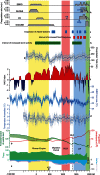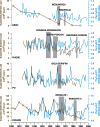Man made deltas
- PMID: 23722597
- PMCID: PMC3668317
- DOI: 10.1038/srep01926
Man made deltas
Abstract
The review of geochronological and historical data documents that the largest southern European deltas formed almost synchronously during two short intervals of enhanced anthropic pressure on landscapes, respectively during the Roman Empire and the Little Ice Age. These growth phases, that occurred under contrasting climatic regimes, were both followed by generalized delta retreat, driven by two markedly different reasons: after the Romans, the fall of the population and new afforestation let soil erosion in river catchments return to natural background levels; since the industrial revolution, instead, flow regulation through river dams overkill a still increasing sediment production in catchment basins. In this second case, furthermore, the effect of a reduced sediment flux to the coasts is amplified by the sinking of modern deltas, due to land subsidence and sea level rise, that hampers delta outbuilding and increases the vulnerability of coastal zone to marine erosion and flooding.
Figures




Similar articles
-
Global-scale human impact on delta morphology has led to net land area gain.Nature. 2020 Jan;577(7791):514-518. doi: 10.1038/s41586-019-1905-9. Epub 2020 Jan 22. Nature. 2020. PMID: 31969725
-
Co-evolution of wetland landscapes, flooding, and human settlement in the Mississippi River Delta Plain.Sustain Sci. 2016;11(4):711-731. doi: 10.1007/s11625-016-0374-4. Epub 2016 May 26. Sustain Sci. 2016. PMID: 30174740 Free PMC article.
-
The impact of contemporary changes in climate and land use/cover on tendencies in water flow, suspended sediment yield and erosion intensity in the northeastern part of the Don River basin, SW European Russia.Environ Res. 2019 Aug;175:468-488. doi: 10.1016/j.envres.2019.03.057. Epub 2019 Mar 28. Environ Res. 2019. PMID: 31158565
-
Climate and land-use changes affecting river sediment and brown trout in alpine countries--a review.Environ Sci Pollut Res Int. 2009 Mar;16(2):232-42. doi: 10.1007/s11356-008-0075-3. Epub 2008 Dec 2. Environ Sci Pollut Res Int. 2009. PMID: 19048320 Review.
-
Relating sediment impacts on coral reefs to watershed sources, processes and management: a review.Sci Total Environ. 2014 Jan 15;468-469:1138-53. doi: 10.1016/j.scitotenv.2013.09.030. Epub 2013 Oct 10. Sci Total Environ. 2014. PMID: 24121565 Review.
Cited by
-
Assessing the human footprint on the sea-floor of coastal systems: the case of the Venice Lagoon, Italy.Sci Rep. 2019 Apr 29;9(1):6615. doi: 10.1038/s41598-019-43027-7. Sci Rep. 2019. PMID: 31036875 Free PMC article.
-
Research on the Limit Values of Reclamation Based on Ecological Security: A Case Study of Tongzhou Bay in Rudong, Jiangsu Province.Int J Environ Res Public Health. 2022 Jul 7;19(14):8301. doi: 10.3390/ijerph19148301. Int J Environ Res Public Health. 2022. PMID: 35886154 Free PMC article.
-
The Po Delta is restarting progradation: geomorphological evolution based on a 47-years Earth Observation dataset.Sci Rep. 2018 Feb 22;8(1):3457. doi: 10.1038/s41598-018-21928-3. Sci Rep. 2018. PMID: 29472570 Free PMC article.
-
Anatomy of Mississippi Delta growth and its implications for coastal restoration.Sci Adv. 2018 Apr 11;4(4):eaar4740. doi: 10.1126/sciadv.aar4740. eCollection 2018 Apr. Sci Adv. 2018. PMID: 29651463 Free PMC article.
References
-
- Coleman J. M. & Wright L. D. Modern river deltas; variability of processes and sand bodies. In: Broussard, M.L., (Eds.), Deltas; Models for Exploration, Houston Geological Society, Texas, pp. 99–149 (1975).
-
- Galloway W. E. Process framework for describing the morphologic and stratigraphic evolution of deltaic depositional systems. In: Broussard,M.L., (Eds.), Deltas; Models for Exploration, Houston Geological Society, Texas, pp. 87–98 (1975).
-
- Syvitski J. P. M. & Saito Y. Morphodynamics of deltas under the influence of humans. Global and Planetary Change 57, 261–282 (2007).
-
- Törnqvist T. E. & Hijma M. P. Links between early Holocene ice-sheet decay, sea-level rise and abrupt climate change. Nature Geoscience 5, 601–606 (2012).
-
- Stanley J. D. & Warne A. G. Worldwide Initiation of Holocene Marine Deltas by Deceleration of Sea-Level Rise. Science 265, 228–231 (1994). - PubMed
Publication types
MeSH terms
LinkOut - more resources
Full Text Sources
Other Literature Sources

